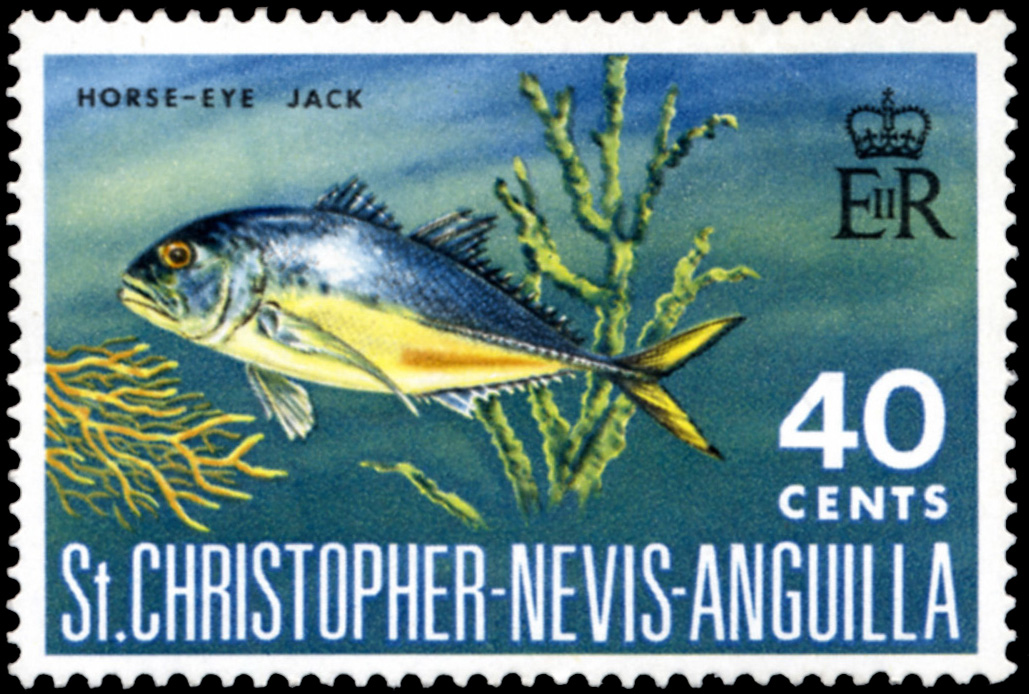Caranx crysos Mitchill, 1815

(Da:fishdb.co.uk)<7br>
Phylum: Chordata Haeckel, 1874
Subphylum: Vertebrata Lamarck J-B., 1801
Classe: Actinopterygii Klein, 1885
Ordine: Perciformes Bleeker, 1859
Famiglia: Carangidae Rafinesque, 1815
Genere: Caranx Lacepède, 1801
Italiano: Carango mediterraneo
English: Blue runner
Français: Carangue tête ronde
Deutsch: Palometa
Español: Cojinuda negra
Descrizione
Il corpo è fusiforme ma compresso lateralmente, ha più o meno la stessa curvatura sul lato ventrale e su quello dorsale. L'occhio, abbastanza grande, ha una palpebra simile a quella del cefalo o del sugarello, la bocca raggiunge la pupilla. Le pinne pettorali sono più corte che nel carango cavallo e raggiungono l'inizio delle pinne pinna anale e seconda dorsale, che hanno lobi appuntiti poco rilevati. La linea laterale ha le squame ingrossate (scudetti) su una porzione rettilinea abbastanza lunga. Il colore è grigio o verdognolo sul dorso e argentato o dorato su fianchi e ventre. Misura al massimo 60 cm di lunghezza per 1,5 kg di peso. Si riproduce in estate in acque costiere.
Diffusione
Si trova nell'Oceano Atlantico sia orientale (da Gibilterra all'Angola) che occidentale ( da New York al Brasile) e nel mar Mediterraneo, soprattutto orientale ed è penetrato nel canale di Suez effettuando un percorso inverso rispetto alla migrazione lessepsiana. Nei mari italiani è raro. È pelagico costiero, si incontra soprattutto su fondali sabbiosi.
Sinonimi
= Carangoides crysos Mitchill, 1815 = Carangoides fusus Geoffroy Saint-Hilaire, 1817 = Caranx fusus Geoffroy Saint-Hilaire, 1817 = Caranx pisquetus Cuvier, 1833 = Paratractus crysos Mitchill, 1815 = Scomber chrysos Mitchill, 1815 = Scomber crysos Mitchill, 1815 = Trachurus squamosus Gronow, 1854.
Bibliografia
–Herdson, D. (2010). "Caranx crysos". IUCN Red List of Threatened Species. 2010.
–J. S. Nelson; T. C. Grande; M. V. H. Wilson (2016). Fishes of the World (5th ed.). Wiley. pp. 380-387.
–Mitchill, S.L. (1815). "The fishes of New York described and arranged". Transactions of the Literary and Philosophical Society of New York. Van Winkle and Wiley. 1: 355-492.
–Froese, Rainer; Pauly, Daniel (eds.) (2009). "Caranx crysos" in FishBase. May 2009 version.
–Munro, J. L. (1983) [1974]. "The Biology, Ecology and Bionomics of the Jacks, Carangidae". Caribbean Coral Reef Fishery Resources (A second edition of The biology, ecology, exploitation, and management of Caribbean reef fishes : scientific report of the ODA/UWI Fisheries Ecology Research Project, 1969-1973, University of the West Indies, Jamaica.). Manila: International Center for Living Aquatic Resources Management. pp. 82-94.
–Jennings, G.H. (1999). Sea fishes of the Caribbean Sea & Gulf of Mexico: Guyana to Florida: a classified taxonomic checklist of recorded species from the West Central Atlantic area. Calypso Publications. p. 149.
–Nichols, J.T. (1920). "On Caranx crysos, Etc". Copeia. American Society of Ichthyologists and Herpetologists. 81 (81): 29-30.
–Fischer, W.; Krupp F.; Schneider W.; Sommer C.; Carpenter K.E.; Niem V.H. (1995). Guía FAO para la identificación de especies para los fines de la pesca. Pacífico centro-oriental. Volumen II. Vertebrados - Parte 1. Rome: FAO. p. 953.
–Reed, David L.; Carpenter, Kent E.; deGravelle, Martin J. (2002). "Molecular systematics of the Jacks (Perciformes: Carangidae) based on mitochondrial cytochrome b sequences using parsimony, likelihood, and Bayesian approaches". Molecular Phylogenetics and Evolution. 23 (3): 513-524.
–Carpenter, K.E., ed. (2002). The living marine resources of the Western Central Atlantic. Volume 3: Bony fishes part 2 (Opistognathidae to Molidae), sea turtles and marine mammals (PDF). FAO Species Identification Guide for Fishery Purposes and American Society of Ichthyologists and Herpetologists Special Publication No. 5. Rome: FAO. p. 1438.
–Fischer, W; Bianchi, G.; Scott, W.B. (1981). FAO Species Identification Sheets for Fishery Purposes: Eastern Central Atlantic Vol 1. Ottawa: Food and Agricultural Organization of the United Nations.
–McEachran, J.D.; J.D. Fechhelm (2005). Fishes of the Gulf of Mexico: Scorpaeniformes to tetraodontiformes. Austin, TX: University of Texas Press. p. 1014.
–Berry, F.H. (1960). "Scale and scute development of the carangid fish Caranx crysos (Mitchill)". Quarterly Journal of the Florida Academy of Sciences. 23: 59-66.
–Wirtz, P.; R. Fricke; M.J. Biscoito (2008). "The coastal fishes of Madeira Island - new records and an annotated check-list". Zootaxa. 1715: 1-26.
–Banon Diaz, R.; J.M. Casas Sanchez (1998). "First record of Caranx crysos (Mitchill, 1815), in Galician waters". Boletin del Instituto Espanol de Oceanografia. 31 (1–2): 79-81.

|
Data: 25/02/1969
Emissione: Fauna marina autoctona Stato: St. Christopher Nevis Anguilla |
|---|